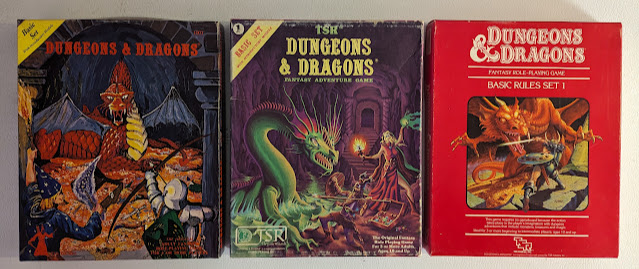I don't think this one is even a contest. That would be Basic-era D&D.
 |
| What treasures in such a small box! |
The Moldvay Basic set was more than just an introductory set to D&D. It was an introduction to a hobby, a lifestyle. The rules were simply written and organized. They were not simple rules, and re-reading them today, I marvel that we all conquered this stuff at age 10-11. It may have only covered the first three levels of character growth, but they were a quality three.
I bought the Expert Set for my birthday in 1982. For the longest time, that was all I needed. Eventually, I moved on to AD&D. I discovered those Little Brown Books and even picked up my own real copy of Holmes Basic. I love those games, and I love playing them still, but they never quite had the same magic as that first time I opened up that box and saw what treasures were inside. I did not have to imagine how my characters felt when they discovered some long-lost treasure. I knew.
Today, I still go back to Tom Moldvay's classic Basic book. It is my yardstick for measuring any OSR game. Almost everything I need is right there, just waiting for me.
Holmes Basic, also called the "Blue Book," was my start. Sort of. The rules I used back when I began were a hodge-podge of Holmes Basic and AD&D, particularly the Monster Manual. This was fine, really, since, at the time, 1979, these game lines were a lot closer to each other. I have talked about this in my "1979 Campaign" posts.
Edited by Dr. John Eric Holmes, this book took the original D&D books and re-edited them to a single cohesive whole, though limited to 3rd level, as a means to get people introduced to the D&D game. The Original Rules (see "O" day!) were an eclectic collection of rules that grew out of Gary Gygax's and Dave Arneson's playstyles. Debate continues on who did what, and I am not going to provide anything close to a definitive answer, but the game sold well but had a steep learning curve to others who were not part of that inner circle or came from War Games. The Holmes Edition attempted to fix that.
Mentzer Basic, or the BECMI (Basic, Expert, Companion, Master, Immortals) rules, was published after the Moldvay Basic, Cook/Marsh Expert sets. The rules between the B/X and BECMI rules are largely superficial (I will discuss this more), and the BECMI rules go past level 14 into the Companion rules (more on that tomorrow).
There is evidence that the Mentzer Basic set, also known as the "Red Box," was one of the best-selling editions of D&D ever, even outselling the flagship line of AD&D at times. It was also sold in more countries and more languages than any other version of D&D. If you recall Sunday's post, the D&D Basic line was in play for 22 years, covering the same time period as AD&D 1st and 2nd Edition rules. And it is still widely popular today.
 |
| Basic books from England, the USA, and Spain |
Basic D&D has great online support regarding books from DriveThruRPG and other "Old School Renaissance" creators. But it is an older game. One of the oldest in fact. So, some things made perfectly good sense back then that would cause people to scratch their heads at the various design choices (Descending Armor Class? Level limits?), but that doesn't detract from the fun. Finding a Basic game or even people to play it with will be harder.
I am participating in Dave Chapman's #RPGaDAY2024 for August.




1 comment:
"Classic" Traveller for me, which surprises some people who know my blog.
Post a Comment